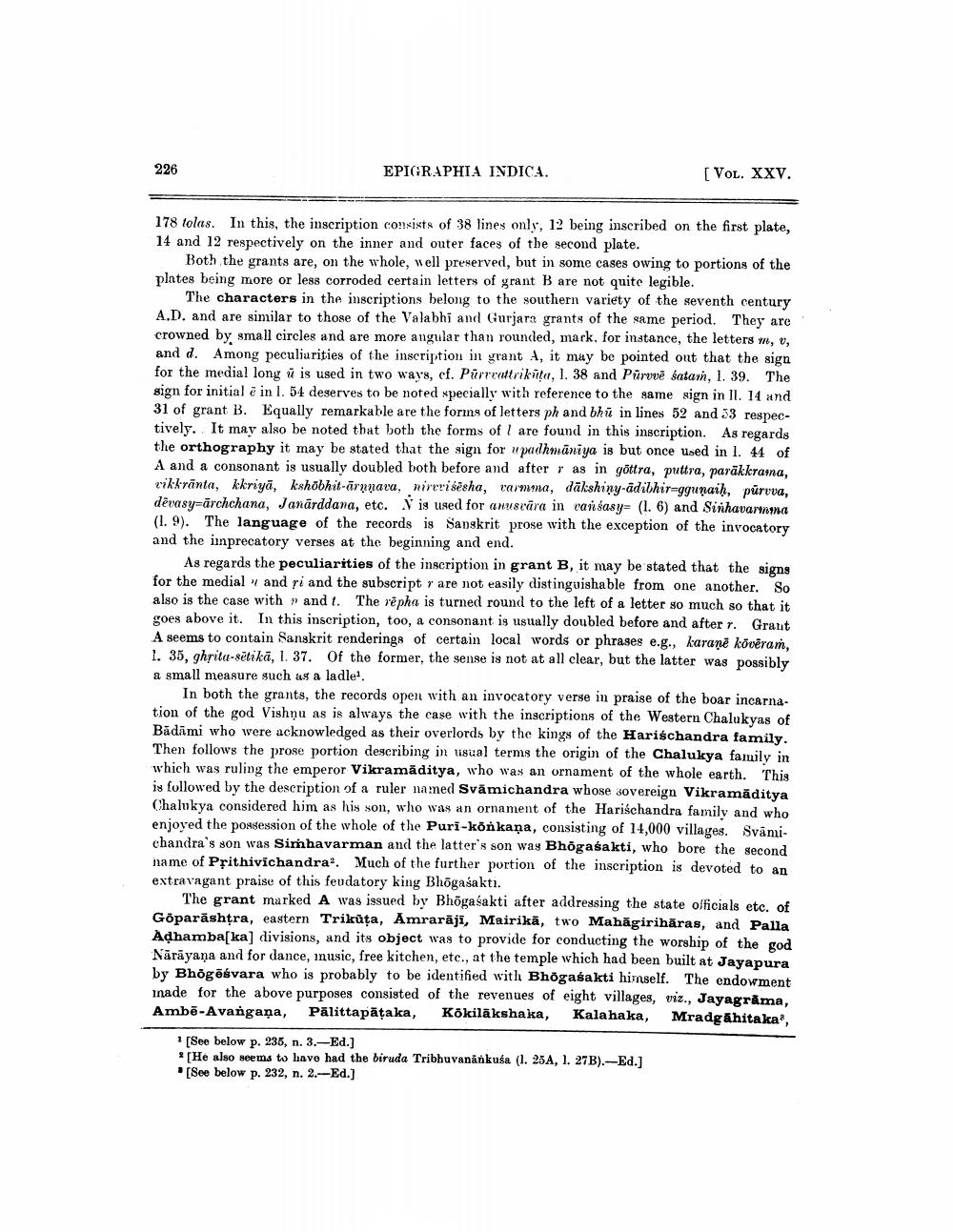________________
226
EPIGRAPHIA INDICA.
[VOL. XXV.
178 tolas. In this, the inscription consists of 38 lines only, 12 being inscribed on the first plate, 14 and 12 respectively on the inner and outer faces of the second plate.
Both the grants are, on the whole, well preserved, but in some cases owing to portions of the plates being more or less corroded certain letters of grant B are not quite legible.
The characters in the inscriptions belong to the southern variety of the seventh century A.D. and are similar to those of the Valabhi and Gurjara grants of the same period. They are crowned by small circles and are more angular than rounded, mark, for instance, the letters m, 0, and d. Among peculiarities of the inscription in grant 4, it may be pointed out that the sign for the medial long ù is used in two ways, cf. Purrruttrikata, 1. 38 and Puruve satan, 1. 39. The sign for initial e in l. 54 deserves to be noted specially with reference to the same sign in II. 14 and 31 of grant B. Equally remarkable are the forms of letters ph and bhū in lines 52 and 53 respectively. It may also be noted that both the forms of l are found in this inscription. As regards the orthography it may be stated that the sign for upadhmāniya is but once used in l. 44 of A and a consonant is usually doubled both before and after r as in yöttra, puttra, parākkrama, rikkrānta, kkriya, kshobhit-ārunava, nirerisesha, rama, dakshiny-adibhirmggunaih, púruva, devasy=ārchchana, Janārddana, etc. V is used for amustära in varsasy- (1. 6) and Sinhavarmma (1.9). The language of the records is Sanskrit prose with the exception of the invocatory and the inprecatory verses at the beginning and end.
As regards the peculiarities of the inscription in grant B, it may be stated that the signs for the medial and ri and the subscript r are not easily distinguishable from one another. So also is the case with and t. The vëpha is turned round to the left of a letter so much so that it goes above it. In this inscription, too, a consonant is usually doubled before and after r. Grant A seems to contain Sanskrit renderings of certain local words or phrases e.g., karanë kõvēram, 1. 35, ghrita-sētikā, 1. 37. Of the former, the sense is not at all clear, but the latter was possibly a small measure such as a ladle!
In both the grants, the records open with an invocatory verse in praise of the boar incarnation of the god Vishnu as is always the case with the inscriptions of the Western Chalukyas of Bādāmi who were acknowledged as their overlords by the kings of the Harischandra family. Then follows the prose portion describing in usual terms the origin of the Chalukya family in which was ruling the emperor Vikramaditya, who was an ornament of the whole earth. This is followed by the description of a ruler named Svāmichandra wbose sovereign Vikramāditya Chalukya considered him as his son, who was an ornament of the Harischandra family and who enjoyed the possession of the whole of the Puri-konkaņa, consisting of 14,000 villages. Svanichandra's son was Simhavarman and the latter's son way Bhögaśakti, who bore the second name of Přithivichandra'. Much of the further portion of the inscription is devoted to an extravagant praise of this feudatory king Bhögasakti.
The grant marked A was issued by Bhögaśakti after addressing the state officials etc. of Göparashtra, eastern Triküța, Amrarājī, Mairikā, two Mahāgirihāras, and Palla Adhamba[ka] divisions, and its object was to provide for conducting the worship of the god Näräyana and for dance, music, free kitchen, etc., at the temple which had been built at Jayapura by Bhögēsvara who is probably to be identified with Bhögasakti himself. The endowment inade for the above purposes consisted of the revenues of eight villages, viz., Jayagrăma, Ambē-Avangaña, Pälittapātaka, Kokilākshaka, Kalahaka, Mradgāhitaka,
[See below p. 235, n. 3.-Ed.] [He also seems to have had the biruda Tribhuvanankuša (1. 25A, 1. 27B).-Ed.] [See below p. 232, n. 2.--Ed.]




